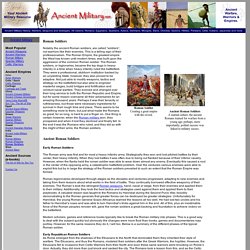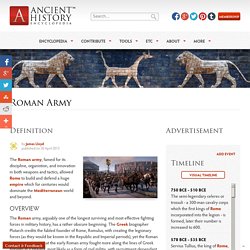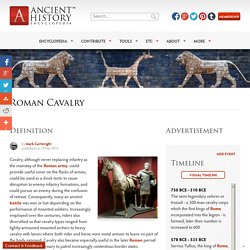

Amerikan kulttuurit.
Mariuksen reformien jälkeisen sotilaan varustus. Rooman legioonien jaokset. The Roman Army. The Roman Army was extremely important in explaining the success of the Romans and the expansion of the Roman Empire.

The Roman Army, at the peak of its power, conquered what we now call England/Wales, Spain, France, most of Germany, the northern coast of Africa, the Middle East and Greece. The Ancient Roman equivalent would be: The Roman Army is recognised by historians as an extremely effective fighting machine. Ironically, its success also led to its downfall. The lowest level of soldier in the Roman Army was the legionnaire. A legionnaire went into battle equipped with three main weapons. Along with these weapons, the legionnaire carried a curved shield called a scutum.
MLA Citation/Reference.
Jerusalemin ryöstö. Roman Soldiers. Early Roman Soldiers The Roman army was first and for most a heavy infantry army.

Strategically they won and lost pitched battles by their center, their heavy infantry. When they lost battles it was often due to being out flanked because of their inferior cavalry. However, when the flanks held the roman soldier was able to wear down almost any enemy. Eventually this caused a rout in the center of the opposing army, a catastrophic battlefield problem. Roman legionnaires developed through stages as the decades and centuries progressed, adapting to new enemies and taking from them lessons about what works in the field of battle. Modern scholars, games and reference books typically like to break the Roman military into phases. Early Republican Roman Soldiers As Rome emerged from the shadows of the Etruscans to the North that dominated them they inherited their style of warfare. The heavy Roman soldier remained as deadly as ever during this period however, perhaps even more deadly. Ancient History Encyclopedia. The Roman army, famed for its discipline, organistion, and innovation in both weapons and tactics, allowed Rome to build and defend a huge empire which for centuries would dominate the Mediterranean world and beyond.

Overview The Roman army, arguably one of the longest surviving and most effective fighting forces in military history, has a rather obscure beginning. The Greek biographer Plutarch credits the fabled founder of Rome, Romulus, with creating the legionary forces (as they would be known in the Republic and Imperial periods), yet the Roman historian Livy says that the early Roman army fought more along the lines of Greek hoplites in a phalanx, most likely as a form of civil militia, with recruitment dependant on a citizen’s social standing. King Servius Tullius (c. 580- 530 BCE) introduced six classes of wealth upon Rome’s citizens; the lowest group had no property and were excluded from the military, whilst the highest group, the equites, formed the cavalry. Sources Centurion 1. Legioonan muodostuminen. Primary History - Romans - The Roman army.
Roman Army Part I. The Roman Army in the Late Republic and Early Empire NB: Over the centuries, the Roman army changed and developed, and conditions often differed somewhat depending on the provinces where the troops were fighting and stationed.

The following information is intended to give a generic picture of military organization, armor, weaponry, etc. during the late Republic and early Empire. LEGIONS (legio): The legion was the basic unit of Rome's standing army of career soldiers, the legionaries, who were all Roman citizens and fought primarily as foot-soldiers (infantry). The number of legions under arms varied in different time periods (there were, for example, 28 legions under Augustus in 25 BCE), and each legion had both a number and a title, though some numbers were duplicated (we know, for example, of III Augusta, III Cyrenaica, III Gallica, III Italica, III Parthica).
Ancient History Encyclopedia. Cavalry, although never replacing infantry as the mainstay of the Roman army, could provide useful cover on the flanks of armies, could be used as a shock tactic to cause disruption to enemy infantry formations, and could pursue an enemy during the confusion of retreat.

Consequently, many an ancient battle was won or lost depending on the performance of mounted soldiers. Increasingly employed over the centuries, riders also diversified so that cavalry types ranged from lightly-armoured mounted archers to heavy cavalry with lances where both rider and horse wore metal armour to leave no part of the body exposed. Cavalry also became especially useful in the later Roman period when it became necessary to patrol increasingly contentious border states. Equites The first Roman cavalry were the semi-legendary celeres or trossuli.
Auxilia From the 1st century BCE cavalry members most often came from provinces outside Italy and allied states could also provide cavalry forces when required. Legioonien mobilisointi.
Barbaarien hyökkäys.